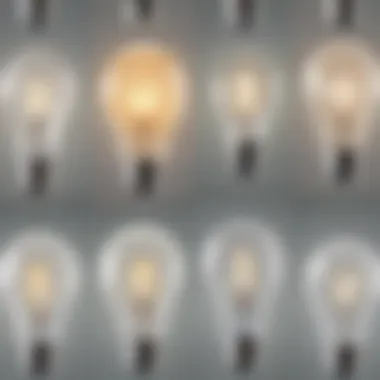Unraveling the Intricacies of Smart Light Bulb Technology


This article takes a detailed look into the complex inner workings of smart light bulbs, shedding light on the advanced technology that powers these innovative devices reshaping our lighting landscapes. By dissecting the intricate mechanisms that drive smart bulbs, readers will gain a holistic understanding of their functionality and the potential advantages of incorporating these intelligent lighting solutions into residential or commercial spaces.
Introduction to Smart Light Bulb Technology
Smart light bulbs embed cutting-edge technology that enables users to control various aspects of illumination remotely using smartphones or voice commands. These bulbs leverage wireless communication protocols such as Bluetooth or Wi-Fi to interact with smart home systems, granting users unparalleled flexibility and convenience in managing their lighting environment.
Components and Functions of Smart Bulbs
Key components of smart light bulbs include LED modules for illumination, embedded microprocessors for executing commands, and sensors for detecting ambient conditions. These bulbs can adjust brightness levels, color temperature, and even be synchronized with music or alarms, offering users a customizable and immersive lighting experience like never before.
Integration with Smart Home Ecosystems
Smart light bulbs seamlessly integrate into broader smart home ecosystems, synergizing with devices like smart thermostats, security cameras, and voice assistants to create a cohesive and intuitive smart living environment. Through centralized control platforms, users can create schedules, customize lighting scenes, and even automate lighting based on occupancy or time of day.
Benefits of Smart Lighting Solutions
The adoption of smart light bulbs brings a multitude of benefits, including energy efficiency through the use of LED technology, enhanced ambiance through customizable lighting scenes, and improved convenience with remote control capabilities. Moreover, smart bulbs contribute to home security by offering features like simulated occupancy while homeowners are away, bolstering peace of mind and enhancing overall lifestyle quality.
Conclusion
Introduction to Smart Light Bulbs
Smart light bulbs represent a significant advancement in lighting technology, offering enhanced control and efficiency. The ability to remotely manage lighting settings via smart devices has transformed how we interact with our living spaces. This article aims to delve into the intricate workings of smart light bulbs, providing a detailed exploration of the technology driving these innovative devices and the practical benefits they bring to both residential and commercial environments.
Overview of Smart Lighting Technology
Evolution of Lighting Technology
Smart light bulbs trace their roots back to the evolution of lighting technology, marking a pivotal shift from traditional incandescent bulbs towards energy-efficient LED solutions. The transition to smart bulbs has revolutionized the lighting industry, offering consumers greater flexibility and customization options.
Introduction to Smart Bulbs
The introduction of smart bulbs heralds a new era in lighting control, granting users the ability to adjust brightness levels, colors, and even create personalized lighting schedules. These smart devices seamlessly integrate into modern smart home ecosystems, enhancing convenience and energy management.
Benefits of Smart Lighting
Smart lighting solutions bring a myriad of benefits, including energy conservation, customizable ambiance settings, and improved security through remote monitoring. The adaptability of smart bulbs to user preferences and environmental conditions underscores their significance in modern lighting applications.
Key Components of Smart Bulbs
LED Technology


LED technology lies at the core of smart bulbs, offering energy-efficient illumination with long lifespans and vibrant color options. The low power consumption and adjustable brightness levels make LED technology a preferred choice for smart lighting setups.
Connectivity Features
The integration of connectivity features such as Wi-Fi and Bluetooth enables seamless control of smart bulbs via smartphones or voice commands. This connectivity empowers users to manage lighting settings remotely and integrate smart bulbs into broader home automation systems.
Integrated Sensors
Smart bulbs often incorporate integrated sensors for motion detection, ambient light adjustments, and energy optimization. These sensors enhance the functionality of smart bulbs by automating lighting responses based on occupancy and environmental conditions.
Types of Smart Light Bulbs
Wi-Fi Enabled Bulbs
Wi-Fi enabled bulbs enable direct connectivity to home networks, facilitating instantaneous control and scheduling through dedicated mobile applications. The simplicity and reliability of Wi-Fi connectivity make these bulbs popular choices for residential smart lighting installations.
Bluetooth-Controlled Bulbs
Bluetooth-controlled bulbs offer localized control within limited ranges, ideal for individual room settings or small-scale smart lighting arrangements. The inherent privacy and efficiency of Bluetooth connections make these bulbs suitable for personal or targeted lighting configurations.
Zigbee and Z-Wave Compatible Bulbs
Zigbee and Z-Wave compatible bulbs leverage mesh networking protocols for seamless communication across smart home devices. These bulbs excel in creating interconnected lighting environments, promoting scalability and interoperability within comprehensive smart home ecosystems.
Functionality of Smart Light Bulbs
In the realm of smart light bulbs, understanding their functionality is paramount. These intelligent lighting solutions go beyond mere illumination, offering a plethora of features that enhance the lighting experience. Smart bulbs not only provide efficient lighting but also allow for seamless integration into smart home systems, enabling users to customize their lighting preferences with ease. The convenience and versatility of smart light bulbs make them a staple in modern lighting design, catering to the needs of those seeking flexible and innovative lighting solutions.
Wireless Connectivity
Interaction with Smart Hubs
When delving into the intricate workings of smart light bulbs, the interaction with smart hubs emerges as a crucial aspect. Smart hubs serve as central control units, facilitating communication between various smart devices within a network. The seamless connectivity achieved through smart hubs ensures efficient operation and coordination of smart light bulbs with other intelligent devices. This integration streamlines the user experience, allowing for personalized control and automation of lighting settings.
Mobile App Control
Another vital element in the functionality of smart light bulbs is mobile app control. Through dedicated mobile applications, users can remotely manage and adjust their lighting preferences with a simple tap on their smartphones. This feature offers unparalleled convenience, enabling users to customize lighting scenes, adjust brightness levels, and set schedules from anywhere. The intuitive interface of mobile apps enhances the user experience, making it effortless to create the desired ambiance within living spaces.
Voice-Activated Commands
Voice-activated commands represent a cutting-edge feature that simplifies the control of smart light bulbs. By leveraging voice assistants like Alexa or Google Assistant, users can command their lights to turn on, off, or change settings through vocal prompts. This hands-free approach revolutionizes the way lighting systems are operated, catering to a more intuitive and futuristic user experience. The seamless integration of voice commands elevates the convenience and accessibility of smart lighting solutions.
Color and Brightness Control


Customized Lighting Scenes
Customized lighting scenes play a pivotal role in enhancing the ambiance and functionality of smart light bulbs. These scenes allow users to set specific combinations of colors, brightness levels, and effects to match various moods or activities. Whether creating a cozy atmosphere for movie nights or boosting productivity with focused lighting, customized scenes offer unparalleled flexibility in lighting control.
Adjustable Color Temperatures
The ability to adjust color temperatures constitutes a valuable feature in smart light bulbs. Users can customize the warmth or coolness of lighting to suit different preferences or settings, such as simulating natural daylight or creating a relaxing evening glow. This adaptability in color temperatures enhances the versatility of smart bulbs, catering to a wide range of lighting needs and aesthetic preferences.
Dimming Capabilities
Dimming capabilities are a sought-after feature that adds sophistication and comfort to smart lighting solutions. Users can regulate the brightness of light output, creating the perfect ambiance for various occasions. Dimming capabilities not only contribute to energy efficiency but also offer greater control over lighting intensity, allowing for a customized lighting experience tailored to individual preferences.
Automation and Scheduling
Setting Timers
The feature of setting timers introduces a new dimension of automation and convenience to smart light bulbs. Users can program their lights to turn on or off at specified times, helping to save energy and enhance security by simulating occupancy when away. This automation feature enables users to streamline their daily routines and optimize energy usage without manual intervention, adding a touch of smart functionality to their homes.
Creating Automated Routines
Creating automated routines empowers users to tailor their lighting preferences to their lifestyle seamlessly. By scheduling predefined actions such as lighting adjustments based on time or activity, users can personalize their smart lighting experience effortlessly. The capability to automate lighting routines not only saves time but also enhances the overall convenience and functionality of smart light bulbs within a smart home ecosystem.
Integration with Smart Home Systems
The integration of smart light bulbs with smart home systems marks a significant advancement in home automation technology. Seamlessly connecting with other smart devices and platforms, smart light bulbs become integral components of a cohesive smart home ecosystem. This integration allows for centralized control, interoperability between different devices, and the creation of sophisticated automation scenarios tailored to specific user preferences, enriching the overall smart home experience.
Advanced Features and Technologies
Smart light bulbs have ushered in a new era of illumination, characterized by their cutting-edge features and technologies. These advanced elements play a crucial role in enhancing the functionality and user experience of smart bulbs. One of the key components is the integration of Internet of Things (IoT) technology. Through IoT integration, smart bulbs can seamlessly communicate with other smart devices in a interconnected network, offering users a streamlined and cohesive smart home experience. Furthermore, smart bulbs equipped with IoT capabilities can facilitate data sharing and analysis, providing users with valuable insights into their lighting usage and preferences. Enhanced security and privacy measures are also paramount in smart light bulbs. Encryption protocols embedded in these devices ensure that data transmissions are secure and protected from external threats. Privacy controls allow users to customize their lighting settings without compromising personal information, while firmware updates ensure that the bulbs are constantly equipped with the latest security enhancements and features.
Internet of Things (IoT) Integration
Smart Home Compatibility
Smart Home Compatibility is a pivotal aspect of IoT integration in smart light bulbs. This feature enables seamless connectivity with popular smart home systems, such as Alexa, Google Assistant, or Apple HomeKit. The compatibility ensures that users can control their lighting setup effortlessly using voice commands, mobile apps, or hubs compatible with these platforms. The versatility and convenience of Smart Home Compatibility make it a sought-after choice for consumers looking to integrate smart lighting into their homes.
Interconnectivity with Other Devices
Interconnectivity with other devices enhances the versatility of smart light bulbs. This feature allows the bulbs to interact with a wide range of smart devices, such as sensors, cameras, and thermostats. By enabling these devices to communicate and coordinate actions, users can create customized automation routines and enhance the overall efficiency of their smart home ecosystem.
Data Sharing and Analysis
Smart light bulbs equipped with data sharing and analysis capabilities offer users valuable insights into their lighting patterns and energy consumption. By analyzing this data, users can optimize their lighting settings for energy efficiency and personalize their lighting experiences. The ability to share data with other smart devices further enhances the interconnectedness of the smart home ecosystem, enabling a more intuitive and responsive lighting environment.


Enhanced Security and Privacy Measures
Security and privacy are top priorities in the realm of smart light bulbs. Encryption protocols form a critical part of the security architecture of these devices, ensuring that data transmissions remain confidential and immune to cyber threats. Additionally, privacy controls empower users to manage their data and privacy settings effectively, granting them the freedom to customize their lighting preferences without compromising personal information. Firmware updates play a crucial role in maintaining the security integrity of smart bulbs, ensuring that they are equipped with the latest security patches and features to safeguard against potential vulnerabilities.
Encryption Protocols
Encryption protocols provide robust security measures for smart light bulbs, safeguarding data transmissions and ensuring that communication channels remain protected from unauthorized access. By encrypting data exchanges between the smart bulbs and connected devices, encryption protocols prevent sensitive information from falling into the wrong hands, bolstering the overall security posture of the smart lighting system.
Privacy Controls
Privacy controls empower users with the ability to manage their privacy settings and data sharing preferences within the smart lighting ecosystem. By offering granular controls over data collection and usage, privacy controls enable users to personalize their lighting experiences while maintaining control over their personal information. This feature enhances user confidence in smart light bulbs and fosters a more transparent and secure user experience.
Firmware Updates
Firmware updates are essential in ensuring the ongoing security and performance of smart light bulbs. These updates deliver patches for known vulnerabilities, introduce new features, and enhance overall system stability. By regularly updating the firmware of smart bulbs, users can mitigate security risks, improve device compatibility, and ensure that their lighting setup remains at the forefront of technological advancements.
Energy Efficiency and Environmental Impact
Smart light bulbs not only offer advanced features and functionalities but also prioritize energy efficiency and environmental sustainability. These eco-conscious features contribute to minimizing energy consumption, reducing carbon footprints, and promoting a greener lifestyle. By leveraging energy-saving capabilities, sustainability benefits, and carbon footprint reduction strategies, smart light bulbs empower users to illuminate their spaces responsibly while embracing environmentally friendly practices.
Energy-Saving Features
Energy-saving features embedded in smart light bulbs optimize energy usage without compromising lighting quality. These features include dimming capabilities, motion sensors, and scheduling options that allow users to tailor their lighting settings for maximum efficiency. By leveraging energy-saving features, users can significantly reduce their electricity consumption and lower their utility bills while minimizing their environmental impact.
Sustainability Benefits
Sustainability benefits offered by smart light bulbs extend beyond energy efficiency to encompass eco-friendly materials, recyclability, and longevity. These bulbs are designed with sustainable practices in mind, employing materials that are durable, energy-efficient, and environmentally friendly. By choosing smart bulbs with sustainability benefits, users can align their lighting choices with their commitment to environmental stewardship and contribute to a more sustainable future.
Carbon Footprint Reduction
Smart light bulbs play a crucial role in reducing carbon footprints by minimizing energy consumption and promoting eco-friendly practices. Through advanced technologies such as LED lighting, energy-efficient components, and smart sensors, smart bulbs enable users to illuminate their spaces while reducing their carbon emissions. By incorporating smart bulbs with carbon footprint reduction features, users can actively participate in environmental conservation efforts and make a positive impact on the planet.
Conclusion
In delving into the complexities of smart light bulbs, it becomes evident that the impact of these innovative devices extends far beyond mere illumination. Smart lighting not only enhances the aesthetic appeal of spaces but also advances overall energy efficiency and convenience. The ability to customize lighting scenes, adjust color temperatures, and set automated routines signifies a significant shift in how we interact with our environments. By integrating smart bulbs into our homes and businesses, we are embracing a future where lighting is not just functional but intelligent and adaptive. This article has shed light on the transformative potential of smart lighting solutions, paving the way for a more connected and efficient way of lighting our surroundings.
Implications of Smart Lighting
Future Trends and Innovations:
Discussing the evolvement of smart lighting technology into the future reveals promising advancements. The focus on energy efficiency, enhanced connectivity, and improved user interfaces are driving forces shaping the landscape of smart lighting. The integration of AI algorithms for personalized lighting experiences and the incorporation of environmental sensors for adaptive illumination are key trends to watch. Embracing these innovations not only ensures improved user experiences but also contributes to sustainability goals and cost savings. The future of smart lighting is poised to revolutionize how we illuminate our spaces, offering a synergy between technology and comfort.
Integration into Smart Cities:
The integration of smart lighting systems into urban environments marks a significant step towards creating more sustainable and efficient cities. By leveraging networked lighting solutions, cities can optimize energy consumption, enhance public safety, and reduce light pollution. The ability to remotely monitor and control streetlights, coupled with the implementation of adaptive lighting schemes based on real-time data, transforms urban spaces into safer and more environmentally friendly areas. The integration of smart lighting into smart city initiatives underscores a commitment to urban sustainability and citizen well-being.
Consumer Adoption and Acceptance:
Understanding consumer behavior and preferences is crucial in driving the adoption of smart lighting technologies. Consumer awareness regarding energy efficiency, convenience, and customization options plays a pivotal role in the acceptance of smart light bulbs. The availability of user-friendly interfaces, compatibility with smart home ecosystems, and cost-effectiveness are key factors influencing consumer decisions. Addressing concerns related to data security and privacy, while offering seamless integration with existing home setups, is essential to gain consumer trust. The widespread adoption of smart lighting solutions hinges on manufacturers' ability to meet consumer demands for intuitive products that enhance their daily lives.



